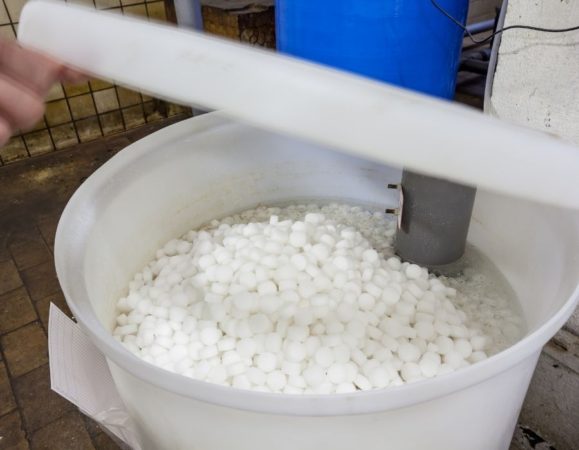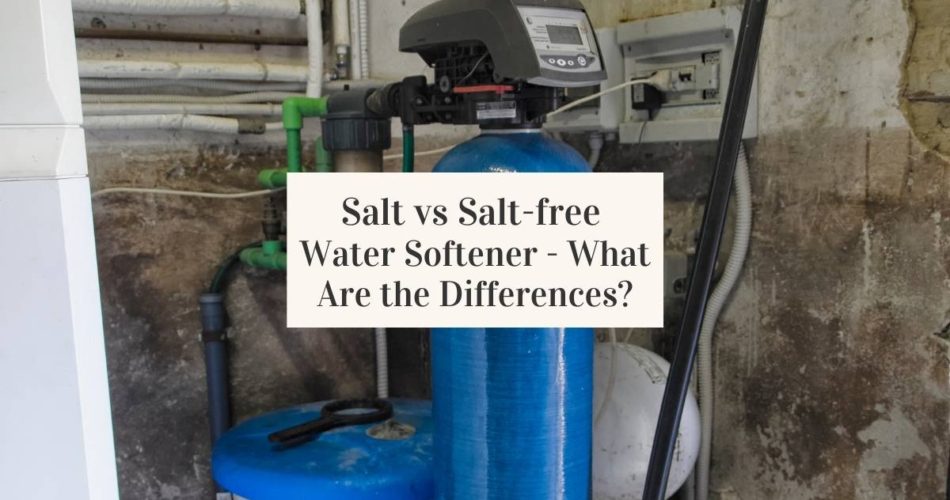While a salt-free water softener (also called a salt-free water conditioner) softens hard water minerals, a salt water softener eliminates hard water minerals. But these are not the only differences in the salt vs salt-free water softener debate.
How a Salt Water Softener Works
A salt-based water softener works by eliminating calcium and magnesium in hard water. They prevent limescale buildup in pipes, fixtures, and appliances such as a water heater. This can be achieved through a process called ion exchange. A softener salt typically replaces these ions present in hard water, either by potassium or sodium ions.
The Ion Exchange Process
The ion exchange process used in salt-based softeners uses a resin bed. This system is extremely effective in removing all grains per gallon of calcium and magnesium. For instance, when your water test on some hard water finds 10 grains per gallon, a water analysis should find 0 grains per gallon after treatment.
Water softeners work using a metered valved fixed on the resin tank. When the water reaches the saturation point, the ion resin bed runs a cleaning cycle. Note that all this time, the water is being metered. The cleaning cycle also involves getting rid of the hardness minerals with a series of backflushes in the system. The sodium ions are periodically replenished in the resin bed. This happens during the cleaning cycle.
How a Salt-free Water Softeners Works
Unlike salt-based softeners, where hardness is dealt with by removing mineral ions, a salt-free system of hardness minerals is retained.
Salt-free softeners work by changing the form of magnesium and calcium ions so that they do not stick to surfaces. That is why they are referred to as salt-free water conditioners. The system conditions the water by crystallizing calcium; however, the calcium ions are not eliminated.
A salt-free system uses template-assisted crystallization, a salt-free process that involves passing water over a catalytic media. This makes the hardness minerals not adhere to surfaces. The hard water minerals are turned into crystals that do not adhere to surfaces.
A water analysis on post-treated water by a salt-free system shows no change in the grains per gallon. The system does not eliminate the scale buildup in your plumbing; however, it is limited.
Scale Prevention Efficiency
Water softeners work to prevent scale buildup in plumbing systems. Salt-based systems use resin beads that release sodium and trap calcium and magnesium ions to soften water. Salt-free systems work by conditioning water without eliminating the mineral ions that cause scaling.
Salt-based systems are 99% efficient in preventing the buildup of limescale in our homes. Since there are several methods that salt-free systems use, the efficiency may differ, ranging from 41%.
Efficiency in Water Usage
There is some difference in water usage efficiency between the two systems. Saltless water softeners are extremely efficient, pegged at 100%; therefore, you waste no water.
Efficiency for a salt-based water softener is rated at about 96%. In providing soft water, salt-based softeners perform periodic regeneration cycles. These cycles are a way for the water treatment system to clean itself. This occurs when the resin bed is concentrated with the hard water minerals flushed out of the softener system. The number of times the system flushes depends on the water needs of the household and water hardness levels.
Ion exchange systems that have an on-demand regeneration are more efficient. For instance, for a family of 4, a typical salt-based water softener will flush approximately 35-65 gallons of water.
Saving Costs on Soap
Salt-based water softeners eliminate the possibility of limescale in hard water. When you apply soap to hard water, soap scum is produced. Soap scum is essentially a nuisance causing damage to clothes, staining toilet bowls and hair.
Salt-based systems help in soap and detergent savings of about $350. Users will use less soap, detergent, and shampoo.
Salt-free systems like Natursoft and Futuresoft do not remove hard minerals that cause the soap scum. They act as salt-free water conditioners, and water forms soap scum during usage. Savings on soap, detergents, and shampoo is therefore negligible.
The Impact on Skins
Saltless water softeners do not eliminate mineral ions. The magnesium and calcium ions interact with soap to form a curd. These curds cause skin dryness and irritation. It destabilizes the balance of the natural oils in your skin, blocking pores that lead to irritation.
When the soap also reacts with the hardness minerals, they produce a thin film of scum that persists after the shower. The film renders moisturizers and lotions ineffective. Those who have skin conditions can easily experience flare-ups or aggravate conditions like dandruff and dermatitis.
The situation is different for salt-based systems. This is because the mineral ions that cause the hardness are eliminated; therefore, no curds are formed.
Environmental Impact
Lately, there has been a clamor for these systems to adhere to environmental standards. There are new innovations that try to reduce the amount of wastewater and ions released into the environment.
Salt-based Water Softener

There are several drawbacks with salt-based water softeners in line with the environment. The main criticism stems from the fact that these water treatment systems while softening water, flush a lot of water as wastewater. Flushing is required to send the undesired hard water mineral ions into the drain or the sewage systems.
There are newer systems that flush only on demand. Critics say that a lot of water is wasted in salt-based systems.
During the regeneration process for salt-based softeners, some chloride and sodium are released into the environment. The amount depends on the water hardness levels.
The hard water minerals are also released into the drains when the softening media is saturated with mineral ions. According to EPA reports, the discharge from the softening media may actually be beneficial to the soil.
There is a positive aspect to using a salt-based water softener. This is because it means that less soap, detergents, and shampoo are used for cleaning. These products have compounds and chemicals such as phosphates. The approximate amount of compounds that negatively affect the environment is reduced by about 50%.
Salt-free Water Softeners
A salt-free softener does not require salt. No sodium or chloride ions are released into drains or sewage systems.
The system does not deal with hard water ions in the saltless water softener. Therefore, the hardness levels remain the same. Saltless softeners do not need water to flush out any trapped mineral ions.
Salt-free water softeners will not deal with the soap scum. It means that you need a lot of soap, detergent, and shampoos for cleaning, and you add substantial amounts of phosphates, cleansers, soaps, detergents, and chemicals to the environment.
Energy Usage and Savings
Softeners help in advancing more efficiency in the operations of your household. Salt-based water systems save an average of $200 -$300 per year.
Scale buildup acts as an insulator. In case the buildup occurs in the water heater, energy usage will be less effective.
Studies on the energy efficiency and effectiveness of salt-free water softeners have not been conclusive yet.
Cleaning
Cleaning a salt-based water softener involves several steps. The initial step is to empty the brine tank. The perfect time to do this is when the system is low on salt. Note that you will have to shut off the intake valve. Proceed to clean the inside of the tank with some dishwashing soap and scrubbing.
Empty the tank and rinse the tank thoroughly. Use bleach to assist in rinsing since it is effective in dealing with bacteria. Rinse your tank again and refill it with water. At this point, you can decide to flush the tank before refilling it with salt and water.
Unlike a salt-based system, cleaning salt-free water softeners does not require much. The mechanism does not require any cleaning as there is no salt involved. Check if there is any sediment buildup that should be clean if this system has a prefilter.
Maintenance
Maintenance forms a key aspect for many households on which system to select—salt-based systems demand much more attention than salt-free water softeners.
Salt-based Water Softener
Maintaining water softeners requires periodic cleaning of the constituent components of the softener system. Maintenance involves cleaning the brine tank, the venturi valve, the system motor, and the resin bed.
Another important maintenance aspect is the timing parameters useful in regeneration that need to be set. Check on the need for refilling salt, usually monthly.
You need to occasionally check the salt bridge which occurs in the brine tank. Salt mush is another major issue that occurs at the bottom of the brine tank, where dissolved salts solidify and form a sludge.
Maintenance also ensures that the system achieves the maximum possible lifespan.
Salt-free Water Softeners
A salt-free system requires little maintenance and only if you have installed a water filter such as a whole house water filtration system. You need to replace your filter yearly.
Laundry
With a salt-based softener, doing laundry, especially white and brightly colored clothes, is easier. You can easily clean your clothes because the soap lathers easily and the colors are more vivid.
With salt-free systems, laundry becomes dry and stiff. This is because the hard water minerals are still persistent in the water.
Operational Costs
A medium-sized salt-based water softener will utilize up to $5 in electricity yearly. Additional costs include up to $50 in salt.
Salt-free water softeners may need up to $225, depending on the method they utilize. Electricity cost will typically range between $0-$25 again, depending on the method used.
The Ideal Water Softener for Your Home
Water softening has numerous benefits. There are mainly two ways to soften, a salt-based water softener and a salt-free water softener.
The benefits of salt-based softeners may outweigh those of salt-free softeners. A salt-based system will actually deal with the minerals that cause water hardness. A softener salt consisting of sodium makes the water soft.
A saltless system act to negate the effect of the mineral ions in the water, although not eliminating them. In the end, you do not get soft water. The system is ideal for people who worry about maintenance and sodium content in the water.
Summary
There are stark differences between a salt vs salt-free water softener. The main difference is the working mechanism for the two types of softeners.
A salt-based system uses sodium salts to replace the water mineral ions, making the water soft. There is a regeneration cycle that periodically replaces the magnesium and calcium ions with sodium or potassium ions.
Other notable differences in their effect on the environment, prevention of scale buildup, water usage efficiency, and maintenance.



